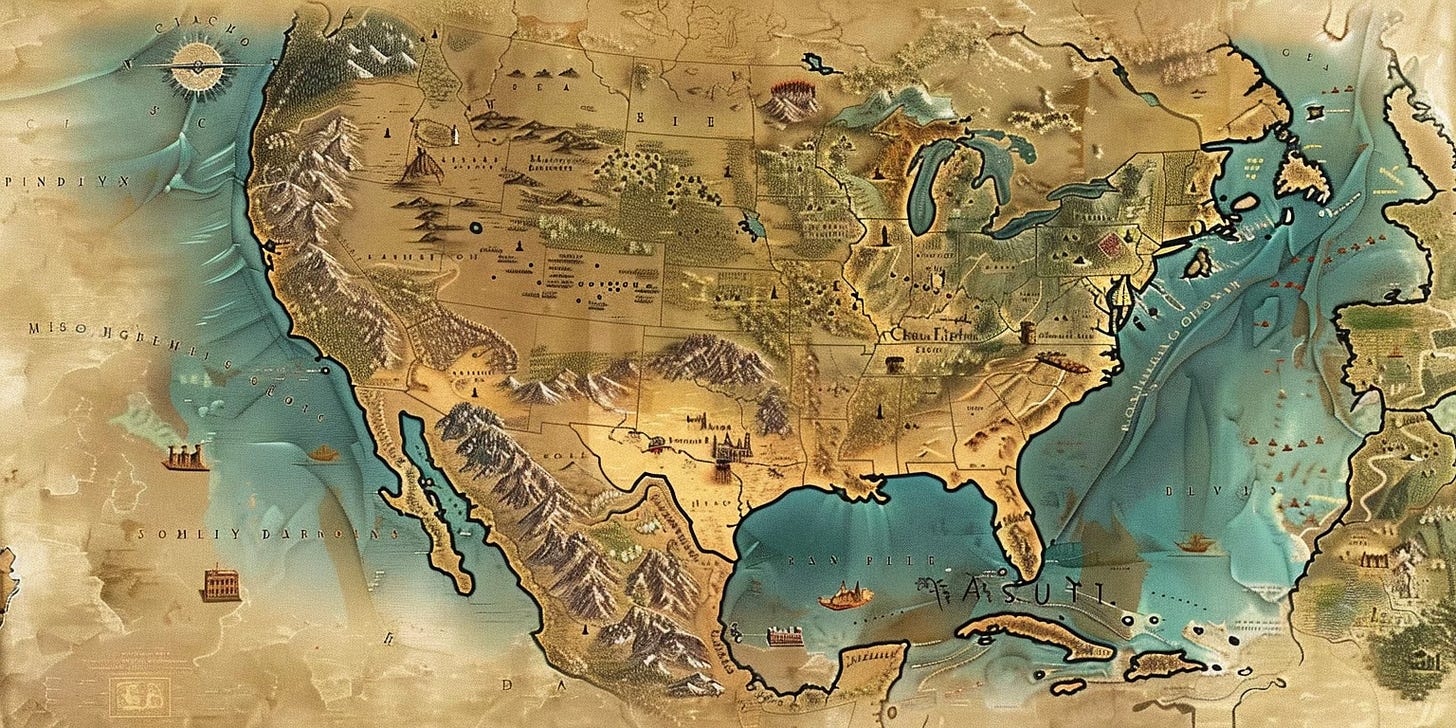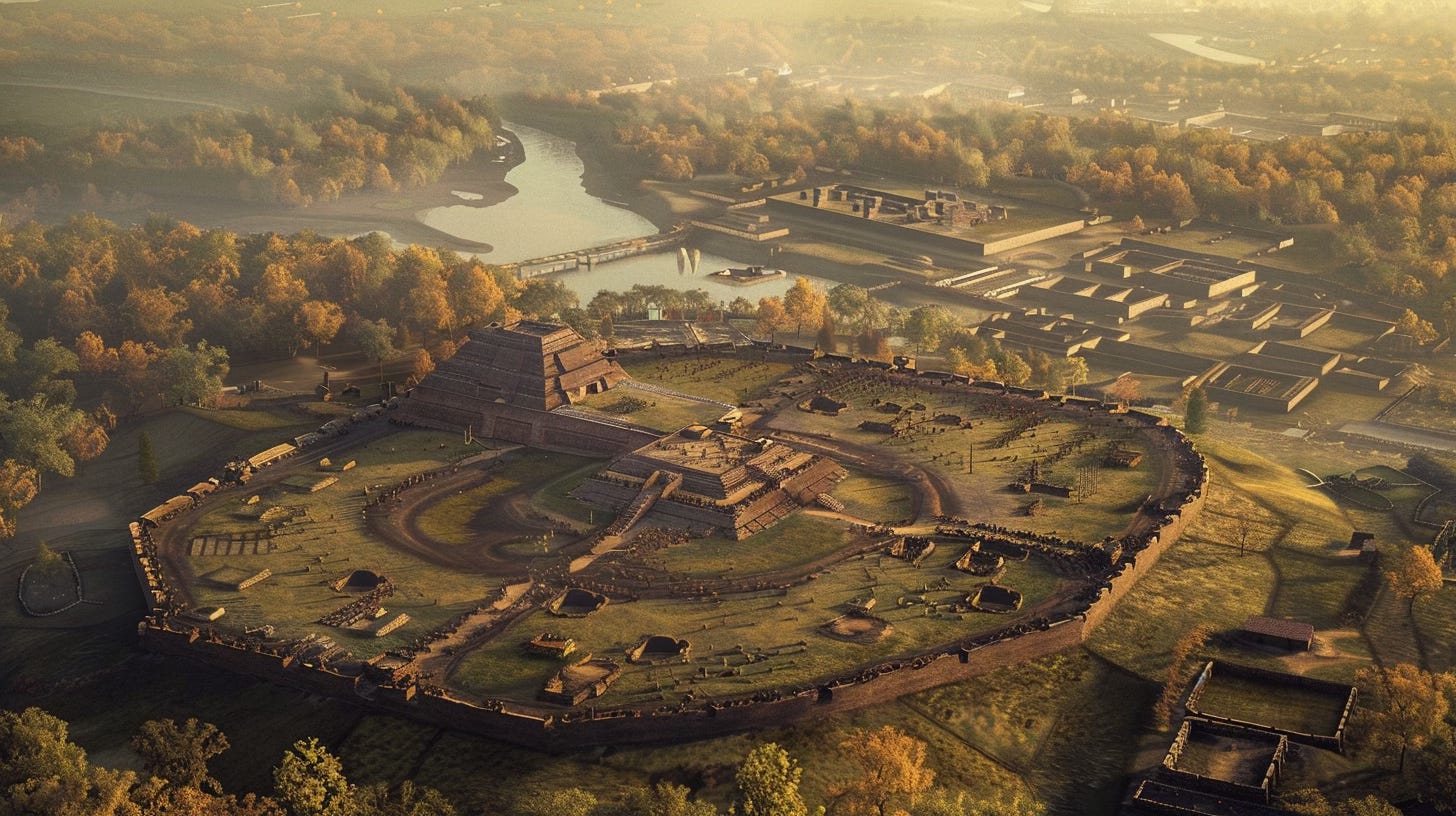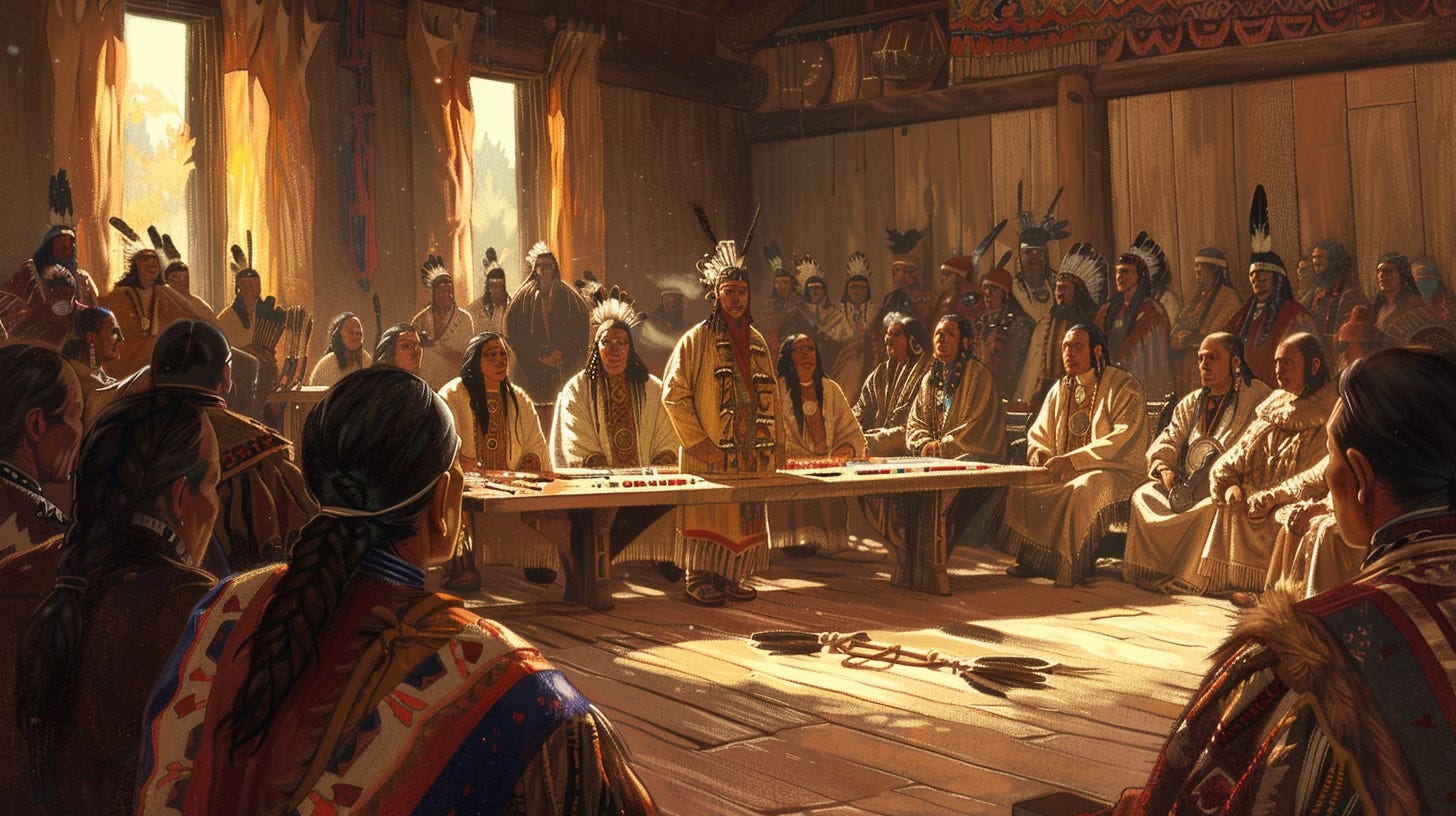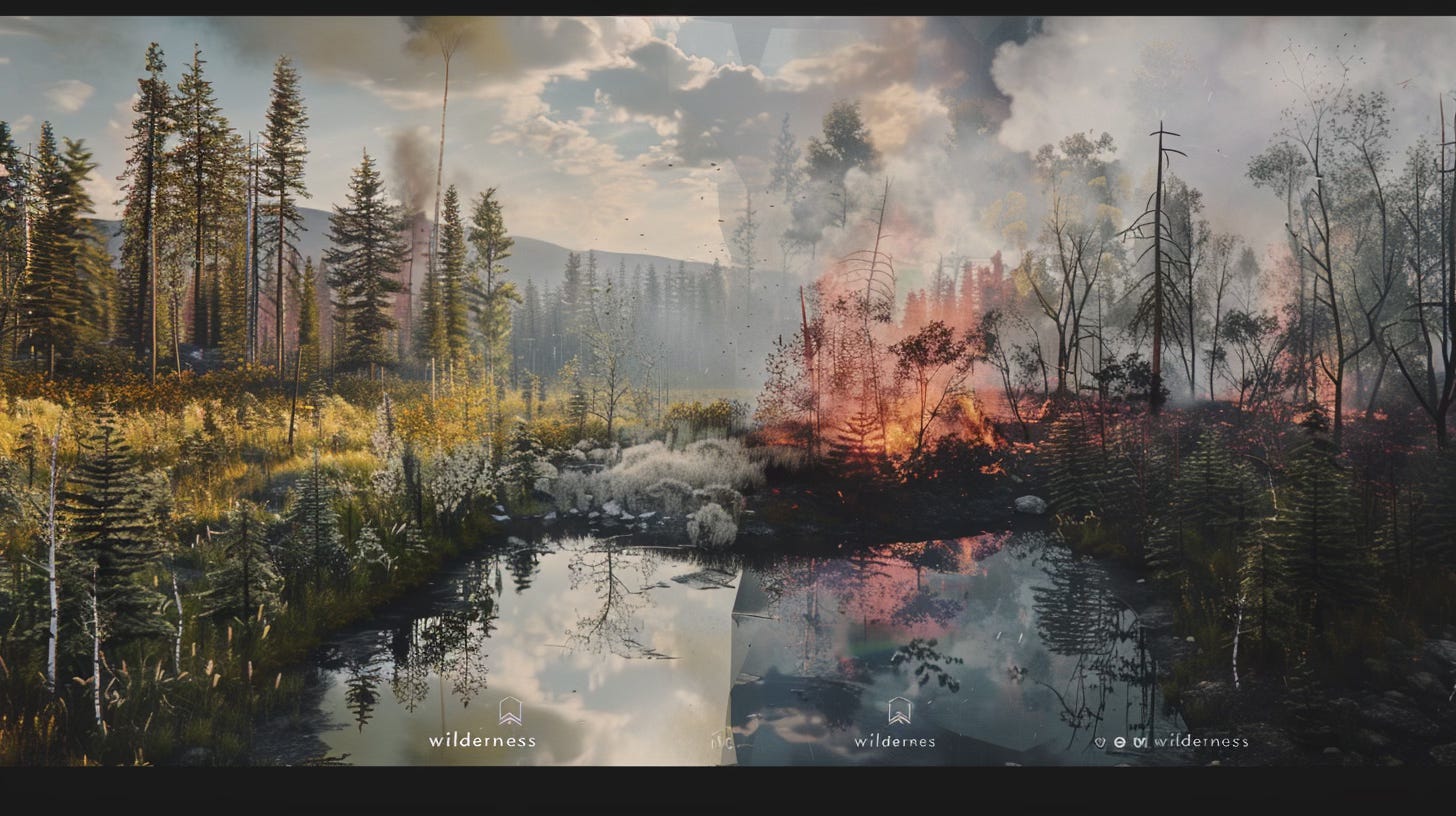Introduction: Encounters in "Unclean" Territory
"They came to the other side of the sea, to the country of the Gerasenes. And when he had stepped out of the boat, immediately a man out of the tombs with an unclean spirit met him." - Mark 5:1-2
When Jesus crosses to "the other side" in Mark's Gospel, he enters territory deemed unclean by Jewish religious authorities. The Gerasene region, populated by Gentiles who raised pigs (animals considered unclean under Jewish law), represented foreign territory both geographically and spiritually. Yet Jesus deliberately enters this space, challenging assumptions about clean and unclean, insider and outsider, civilized and uncivilized.
This boundary-crossing pattern—Jesus consistently moving into spaces deemed "other" by religious authorities—embodies the participatory freedom at the heart of true Biblical Citizenship. Rather than maintaining rigid barriers, Christ demonstrates citizenship in God's kingdom through deliberate engagement across constructed boundaries. This example challenges both Dominative Christianism and our sanitized historical narratives.
European colonizers approached indigenous North America with similar conceptual boundaries—viewing native lands as "wilderness" despite their sophisticated civilizations, indigenous spirituality as "pagan" despite its deep wisdom, and native governance as "primitive" despite its complex social organization. Like the religious authorities of Jesus's day, European settlers often maintained rigid boundaries between "civilized" European society and "savage" indigenous cultures.
This chapter crosses these conceptual boundaries, examining the sophisticated indigenous civilizations that existed in North America long before European arrival. These weren't primitive societies awaiting European "civilization" but complex cultures with advanced agricultural systems, extensive trade networks, sophisticated governance structures, and rich spiritual traditions. By crossing these boundaries in our historical understanding, we develop more truthful perspective on American origins.
Advanced Civilizations Before Contact
Cahokia: America's First City
When my father was growing up just outside St. Louis in the 1940s and 50s, his teachers barely mentioned that he lived near the ruins of what had once been North America's largest city. Cahokia, which at its peak around 1200 CE housed more residents than London at that time, was dismissed as merely a collection of "Indian mounds" rather than recognized as the sophisticated metropolis archaeological evidence has since revealed.
This pattern of invisibility—grand indigenous achievements rendered unseen while European accomplishments dominate our historical gaze—mirrors the palace-manger contrast in the nativity story. Just as Herod's palace commanded attention while divine presence arrived unnoticed in a feeding trough, so too did European settlements command historical attention while sophisticated indigenous civilizations were overlooked or deliberately erased.
THEOLOGICAL INSIGHT: Just as shepherds—not palace courtiers—received the divine announcement in the nativity story, perhaps the fuller truth of American history is revealed not through imperial monuments but through the marginalized histories European settlers attempted to erase.
This Mississippi civilization constructed massive earthworks requiring sophisticated engineering knowledge and organized labor on unprecedented scale. Monk's Mound, the largest prehistoric earthen structure in the Americas, required an estimated 14 million baskets of soil carefully layered to create stable 100-foot-tall pyramid with multiple terraces and buildings on its summit. This construction demonstrated not only engineering skill but also centralized political authority capable of organizing massive labor projects.
Cahokia featured planned urban layout with central plaza, residential neighborhoods, astronomical observatories, and elaborate burial sites indicating complex social stratification. Archaeological evidence reveals sophisticated craft production, nutritional abundance, and extensive trade networks connecting Cahokia to regions from the Great Lakes to the Gulf Coast. Far from primitive village, Cahokia represented urban civilization comparable to contemporaneous European cities.
Walking the Mounds: My Childhood Connection to Mississippian Civilization
Growing up in Baton Rouge in the 1970s, my brothers and I would regularly trek across what we called "the Indian mounds" on LSU's campus before football games at Tiger Stadium. I had no understanding then that these mounds connected to a sophisticated civilization that once dominated the Mississippi River valley. The casual way we treated these archaeological treasures—running up and down them before games, completely disconnected from their historical significance—reflected the broader cultural erasure of indigenous achievements.
Just thirty miles upriver from my childhood home, at the Poverty Point World Heritage Site, stood another testament to indigenous engineering that predated European arrival by millennia. Yet these achievements remained largely invisible in my education—much like the divine presence in a Bethlehem feeding trough remained invisible to the powerful in Jerusalem's palaces.
HISTORICAL INSIGHT: European settlers consistently misinterpreted North American landscapes as "wilderness" despite their careful management by indigenous peoples over millennia. What appeared to European eyes as untouched nature often represented deliberately cultivated environments—a "feeding trough" that nourished civilizations rendered invisible by imperial narrative.
The Mississippian civilization, centered at Cahokia but extending to my childhood hometown, featured sophisticated agricultural practices, elaborate ceremonial traditions, and extensive trade networks. Though less "visibly imperial" than European cities with their stone cathedrals and castles, these societies achieved comparable population densities, cultural sophistication, and technological innovations adapted to their environmental contexts.
Haudenosaunee: Democratic Confederation in My Finger Lakes Home
The Six Nations of the Haudenosaunee (Iroquois) Confederacy—whose names grace the beautiful lakes of my current home in upstate New York—established sophisticated democratic governance system centuries before the formation of the United States. This confederation united the Mohawk, Oneida, Onondaga, Cayuga, Seneca, and later Tuscarora nations into political alliance with representative governance, separation of powers, and balanced authority between centralized and local decision-making.
Living among these lakes named for the Haudenosaunee nations has reinforced for me how indigenous presence becomes simultaneously acknowledged and erased—the names remain while the full acknowledgment of these nations' political sophistication often vanishes. The Cayuga Lake outside my window carries indigenous naming while the Cayuga people themselves were largely driven out—cultural appropriation at geographic scale.
HISTORICAL INSIGHT: The democratic principles we celebrate as uniquely "American" innovations were practiced centuries earlier by the Haudenosaunee, whose political sophistication remains largely unacknowledged in mainstream historical narratives. This invisibility serves the imperial narrative that civilization arrived with European settlement rather than already flourishing here.
The Great Law of Peace (Gayanashagowa) that structured this confederation specified detailed governance procedures including representative councils, mechanisms for removing leaders who violated public trust, and formalized processes for deliberative decision-making. Women held significant political power, with clan mothers selecting male representatives and maintaining authority to remove leaders who failed their duties.
This democratic confederation influenced American constitutional thinking through figures like Benjamin Franklin, who explicitly referenced the Haudenosaunee model during constitutional deliberations. The confederacy's balanced distribution of authority between central government and constituent nations prefigured American federalism, while its deliberative decision-making processes established democratic principles predating European Enlightenment thought.
Hohokam: Hydraulic Engineering
The Hohokam civilization of the American Southwest developed sophisticated irrigation systems that transformed desert environments into productive agricultural landscapes. Between approximately 300 BCE and 1450 CE, they constructed hundreds of miles of precisely engineered canals that distributed water from the Salt and Gila rivers across the arid Phoenix basin.
These canals, up to 30 feet wide and 10 feet deep, required precise mathematical calculation to maintain gentle, consistent gradient that moved water efficiently across flat desert landscape. The irrigation system included headgates to control water flow, distribution canals to deliver water to field systems, and drainage systems to manage excess water—all constructed using stone tools rather than metal implements.
This hydraulic engineering transformed the Sonoran Desert into one of North America's most productive agricultural regions, supporting dense population with minimal environmental degradation. The sustainable water management practices developed by the Hohokam continue to influence southwestern water governance, with modern Phoenix canal systems often following pathways established by these indigenous engineers over a millennium ago.
Three Sisters Agriculture: Sustainable Innovation
Indigenous agricultural innovation created some of world history's most sustainable and productive farming systems. The "Three Sisters" method—planting corn, beans, and squash together in complementary arrangement—represented sophisticated agricultural science that maximized productivity while maintaining soil health.
This polyculture system created symbiotic plant relationships that enhanced overall productivity: corn provided structure for beans to climb, beans fixed nitrogen in soil that nourished corn, and squash's broad leaves suppressed weeds while minimizing water evaporation. This companion planting maintained soil fertility without artificial fertilizers, controlled pests without chemical pesticides, and preserved water resources without mechanical irrigation.
This agricultural system produced complete protein diet with complementary amino acids while requiring less labor and fewer resources than European monoculture farming. The resulting agricultural abundance supported dense, settled populations throughout eastern North America, creating landscape that European settlers often mistook for "wilderness" despite its careful cultivation by indigenous farmers.
Governance and Diplomacy
Complex Political Systems
Indigenous North America featured diverse political systems ranging from relatively egalitarian band societies to hierarchical chiefdoms to complex confederacies with sophisticated governance structures. These political systems developed in response to specific environmental contexts, population densities, and historical circumstances rather than representing uniform "primitive" condition.
Like the imperial palace versus the Bethlehem feeding trough, European governance systems prioritized architectural visibility and centralized power, while indigenous systems often emphasized relationship networks and dispersed authority—differences that European observers consistently misinterpreted as signs of indigenous inferiority rather than alternative governance approaches.
The Southeast featured hierarchical chiefdoms with clear social stratification, monumental architecture, and centralized authority over multiple communities. The Pacific Northwest developed distinctive political systems based on complex gift-giving ceremonies (potlatch) that redistributed wealth while confirming social status. The Great Plains established military societies and inter-tribal councils that managed resources and adjudicated conflicts across vast territories.
These diverse governance systems demonstrated sophisticated political thought responding to specific challenges and opportunities rather than uniform "tribal" organization. Anthropological and archaeological evidence reveals political systems adapting to changing circumstances through constitutional innovation, inter-group diplomacy, and governance experimentation—processes parallel to those occurring in contemporaneous European societies.
Treaty Diplomacy and International Relations
Indigenous nations developed sophisticated diplomatic practices for managing relationships between distinct political communities. These diplomatic traditions included formal protocols for establishing peace, mediating conflicts, regulating trade, and forming alliances that constituted genuine international relations system rather than primitive inter-tribal connections.
Wampum belts served as diplomatic records, with intricate bead patterns recording treaty provisions and alliance terms—functioning similarly to written treaties in European diplomatic tradition. Council meetings followed elaborate protocols ensuring fair representation, thorough deliberation, and mutually beneficial outcomes. Gift exchanges symbolized reciprocal obligations rather than mere present-giving, establishing binding commitments between sovereign entities.
European colonizers initially engaged with this indigenous diplomatic system, recognizing native political communities as sovereign entities through formal treaty-making. The Two Row Wampum treaty between the Haudenosaunee and Dutch settlers symbolized this relationship, with parallel purple lines representing two vessels traveling the same river without interfering with each other—a sophisticated diplomatic concept of mutual recognition between distinct sovereign entities.
Women's Political Power
Many indigenous nations accorded women significant political authority and influence, establishing gender relations that differed markedly from contemporaneous European societies. While specific arrangements varied widely across different indigenous cultures, many featured greater female political participation than found in European governance systems of the same period.
Among the Haudenosaunee, clan mothers selected male representatives to the confederacy council and maintained authority to remove leaders who violated public trust—creating check on male authority absent from European governance. Among many Algonquian peoples, women controlled agricultural production and distribution, giving them significant economic authority that translated into political influence.
These indigenous gender arrangements often shocked European observers accustomed to more patriarchal social structures. European colonial records frequently note with disapproval the "excessive" freedom and authority of indigenous women, revealing how indigenous gender relations challenged European assumptions about "natural" gender hierarchy.
Timeline: Invisible America
Cultural and Intellectual Achievements
Mathematical and Astronomical Knowledge
Indigenous cultures developed sophisticated mathematical and astronomical knowledge systems that enabled everything from architectural precision to agricultural planning to celestial navigation. These knowledge systems, while using different methodologies than European mathematics, demonstrated comparable intellectual sophistication and practical application.
Maya mathematical system (which influenced nations throughout North America through trade networks) included concept of zero centuries before its introduction to Europe, along with place-value notation that enabled complex calculations. Indigenous astronomers throughout North America tracked celestial movements with remarkable precision, creating calendars that coordinated agricultural, ceremonial, and social activities with astronomical cycles.
Physical structures throughout North America incorporated this astronomical knowledge, with buildings and monuments aligned to track solstices, equinoxes, and other celestial events. The Ancestral Puebloan complex at Chaco Canyon functioned partly as astronomical observatory, with structures precisely aligned to mark significant celestial events—demonstrating both mathematical precision and long-term astronomical observation.
Sophisticated Material Technologies
Indigenous cultures developed sophisticated technologies adapted to specific environmental contexts and cultural needs. These technologies represented not primitive approximations of European technologies but distinct innovations optimized for particular contexts—often achieving greater efficiency and sustainability than European alternatives.
Metallurgical traditions in the Great Lakes region created complex copper artifacts without smelting, using sophisticated cold-hammering techniques to create tools, jewelry, and ceremonial objects. Arctic peoples developed insulated housing and sophisticated layered clothing that outperformed European equivalents in extreme conditions—technologies so effective that modern Arctic equipment still incorporates their principles.
Agricultural technologies demonstrated particular sophistication, with tools and techniques carefully adapted to specific crops and environmental conditions. The integrated "Three Sisters" cultivation method represented agricultural science that maintained soil fertility while maximizing nutritional yield—a sustainable system that outperformed European monoculture in both environmental impact and nutritional efficiency.
Literary and Oral Traditions
Indigenous cultures maintained sophisticated literary traditions transmitted through oral rather than written means. These traditions preserved historical knowledge, cultural wisdom, and spiritual insight through carefully structured narrative forms maintained with remarkable fidelity across generations.
Contrary to European assumptions about the unreliability of oral transmission, indigenous cultures developed mnemonic techniques and institutional structures that ensured accurate preservation of knowledge. Specialized knowledge-keepers underwent rigorous training in memorization techniques, with community verification processes providing quality control similar to peer review in written traditions.
These oral traditions preserved not just stories but complex knowledge systems—medicinal properties of hundreds of plants, astronomical observations covering centuries, geographical knowledge spanning vast territories, and historical records of events centuries past. The intellectual sophistication of these traditions rivaled contemporaneous written traditions while maintaining distinctive epistemological approaches centered on relationship rather than abstraction.
Environmental Management and Ecological Knowledge
Managed Landscapes vs. "Wilderness"
European settlers consistently misinterpreted North American landscapes as "wilderness" despite their careful management by indigenous peoples over millennia. What appeared to European eyes as untouched nature often represented deliberately cultivated environments managed through sophisticated ecological knowledge and intentional intervention.
Eastern forests that impressed colonists with their park-like appearance—open understory beneath massive trees—resulted from indigenous burning practices that prevented underbrush accumulation while maintaining mature tree canopy. Prairie ecosystems that supported vast bison herds resulted from deliberate burning regimes that prevented forest encroachment while enhancing grass growth that attracted game animals.
These managed landscapes demonstrated not absence of human influence but different philosophy of environmental relationship—working with natural processes rather than imposing artificial order. Indigenous environmental management created productive landscapes that maintained biodiversity while meeting human needs—achievements that modern ecological restoration often attempts to recreate.
Sustainable Resource Management
Indigenous cultures developed sophisticated resource management systems that maintained environmental health while meeting human needs—achievements particularly relevant as contemporary society confronts environmental degradation resulting from industrial exploitation.
Fishery management systems in the Pacific Northwest maintained salmon abundance through harvest regulations, habitat protection, and ritual practices that embedded ecological knowledge in cultural context. Forest management in eastern North America involved selective harvesting, controlled burning, and cultivation of useful species that enhanced rather than degraded forest ecosystems.
Wildlife management included hunting restrictions that prevented overharvesting, habitat enhancement that supported game populations, and cultural practices that embedded sustainable use within spiritual frameworks emphasizing reciprocal relationship rather than mere extraction. These management systems maintained abundant resources for millennia—until disrupted by European colonization that introduced extractive rather than sustainable resource utilization.
Traditional Ecological Knowledge as Science
Indigenous environmental knowledge represented not primitive superstition but sophisticated science developed through centuries of careful observation, experimental testing, and practical application. This traditional ecological knowledge (TEK) integrated empirical observation with cultural frameworks that emphasized relationship and reciprocity rather than domination and extraction.
Indigenous botanists identified medicinal properties of thousands of plant species, developing pharmacopoeia that treated everything from pain management to infection control to chronic disease. Indigenous ecologists understood complex relationships between different species, managing ecosystems to enhance beneficial interactions while minimizing harmful ones. Indigenous climatologists tracked weather patterns across decades, developing agricultural calendars adapted to specific regional conditions.
This ecological knowledge continues to inform contemporary environmental science, with indigenous land management practices increasingly recognized as effective conservation strategies and indigenous pharmacological knowledge contributing to modern medicine. The scientific validity of TEK demonstrates the intellectual sophistication of indigenous knowledge systems despite their different methodological approaches than Western science.
Personal Reflection: Imagining the Mississippian Matriarchy
In my late thirties, having left naval service and corporate life, I began research for what became a deeply flawed novel set in Mississippian civilization. This creative effort—my attempt to imagine the matriarchal society that archaeological evidence suggested once flourished along the river valleys of my childhood—led me to visit with members of the United Houma Nation in southern Louisiana.
What began as research became a profound boundary-crossing experience, as I encountered not historical artifacts but living communities with continuing traditions and contemporary challenges. The Houma elders I met spoke not about vanished ancestors but about ongoing struggles for federal recognition, land rights threatened by coastal erosion, and cultural traditions maintained despite centuries of marginalization.
A PERSONAL NOTE: "My encounters with the Houma Nation revealed my own spiritual blindness—like the religious authorities who couldn't see God in their midst, I had learned to overlook indigenous presence and contributions despite growing up on land shaped by their civilization. This recognition requires not just historical correction but spiritual transformation.”
My embarrassingly bad novel attempt (thankfully never published) revealed my own ignorance and presumptions—an outsider imagining a culture from archaeological fragments rather than engaging with its living descendants. Yet this boundary-crossing effort, however flawed, began a process of recognizing indigenous communities not as historical curiosities but as continuing peoples with legitimate claims to both historical acknowledgment and contemporary rights.
The divine revelation came not through my academic research but through relationship with living people—much like Jesus consistently encountered divine truth through marginalized communities rather than religious authorities. This pattern of revelation through the overlooked rather than the powerful stands as theological challenge to how we construct our historical narratives.
Implications for Contemporary Debates
Sovereignty and Self-Determination
Understanding indigenous nations as sophisticated civilizations rather than primitive tribes fundamentally changes the framework for contemporary debates about sovereignty and self-determination. If indigenous peoples represented advanced civilizations with legitimate governance systems, territorial claims, and international relations, then their claims to continuing sovereignty rest not on special pleading but on same foundations as any other nation's sovereignty claims.
This historical understanding challenges frameworks that treat indigenous sovereignty as privilege granted by benevolent government rather than inherent right predating United States formation. The sophisticated governance systems that managed North American territories for millennia before European arrival established legitimate sovereignty claims that colonial displacement did not legitimately extinguish.
This perspective doesn't resolve contemporary debates about specific sovereignty implementation but provides essential historical context. Indigenous claims to self-governance and territorial rights emerge not from special treatment but from same principles of political legitimacy that undergird all governmental authority, including that of the United States itself.
Biblical Citizenship Beyond Imperial Borders
Jesus's consistent boundary-crossing in Mark's Gospel provides theological framework for reimagining American citizenship beyond imperial narratives. If citizenship in God's kingdom requires crossing human-constructed boundaries to recognize shared humanity, then American citizenship similarly requires transcending historical narratives that erase indigenous achievements while celebrating European "civilization."
This Biblical Citizenship demands rejecting both Binary Apocalypticism that divides humanity into civilized/savage categories and Disordered Nationalism that privileges European heritage while marginalizing indigenous contributions. Following Jesus's example means recognizing American history as encounter between civilizations rather than European cultivation of wilderness.
This reimagined citizenship doesn't diminish European-derived traditions but places them alongside indigenous contributions within fuller understanding of American origins. A citizenship grounded in participatory freedom acknowledges both indigenous achievements and European contributions while refusing narratives that justify domination of one by the other.
Conclusion: Reclaiming American Origins
Recognizing that America was "already here" before European arrival fundamentally transforms our understanding of American origins. Rather than beginning with European settlement of empty wilderness, American history emerges as story of encounter between sophisticated civilizations with distinctive technologies, governance systems, and cultural traditions.
This recognition doesn't require either demonizing European settlers or idealizing indigenous societies, but rather truthful acknowledgment that North America hosted complex civilizations long before becoming "America." This truthful remembering acknowledges both the genuine achievements of indigenous civilizations and the real disruptions caused by European colonization without reducing either to simplistic narrative.
Jesus's encounter with the Gerasene demoniac in "unclean" territory reminds us that crossing conceptual boundaries often reveals humanity where we've been taught to see only otherness. Similarly, crossing the boundaries established by traditional American narratives reveals sophisticated civilizations where we've been taught to see only primitive tribes. This boundary-crossing leads toward more truthful understanding not just of America's past but of its continuing identity as multicultural society formed through ongoing encounter rather than simple extension of single cultural tradition.
Key Terms
Boundary-Crossing: The theological practice of deliberately moving across established social, religious, or cultural divisions, following Jesus's example of engaging beyond accepted boundaries.
Binary Apocalypticism: The theological mutation that creates rigid good/evil, us/them distinctions that divide the world into opposing camps.
Tribal Epistemology: Knowledge systems based on group identity rather than shared truth-seeking, creating closed information systems that reject outside evidence.
Disordered Nationalism: Theological mutation that elevates national identity above theological identity, creating idolatrous attachment to national narratives over religious commitments.
Biblical Citizenship: Framework for political engagement grounded in theological commitment rather than national identity, recognizing Christians as "aliens and exiles" whose primary loyalty transcends national boundaries.
Related Content
Common Life Politics: Country → (Coming Soon)
Sermon: Mark 5:1-20 (The Gerasene Demoniac) →(Coming Soon)
Notes
[1] Charles C. Mann, 1491: New Revelations of the Americas Before Columbus (New York: Knopf, 2005).
[2] Barbara Alice Mann, Iroquoian Women: The Gantowisas (New York: Peter Lang, 2000).
[3] M. Kat Anderson, Tending the Wild: Native American Knowledge and the Management of California's Natural Resources (Berkeley: University of California Press, 2005).
[4] Gregory Cajete, Native Science: Natural Laws of Interdependence (Santa Fe: Clear Light Publishers, 2000).

















